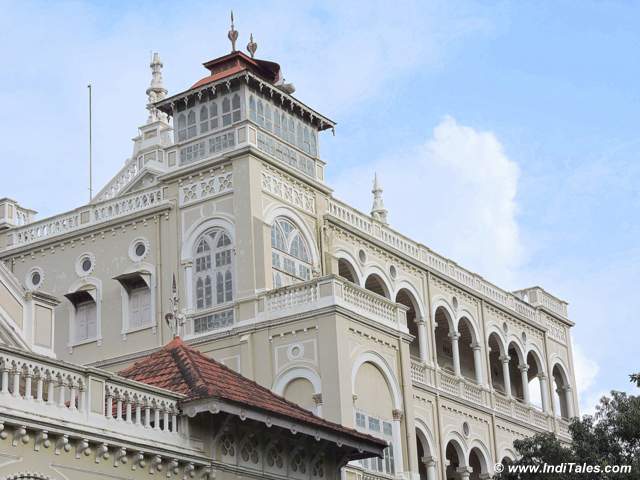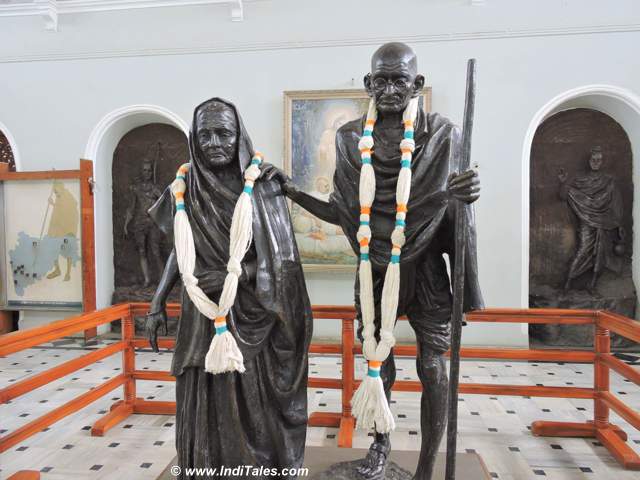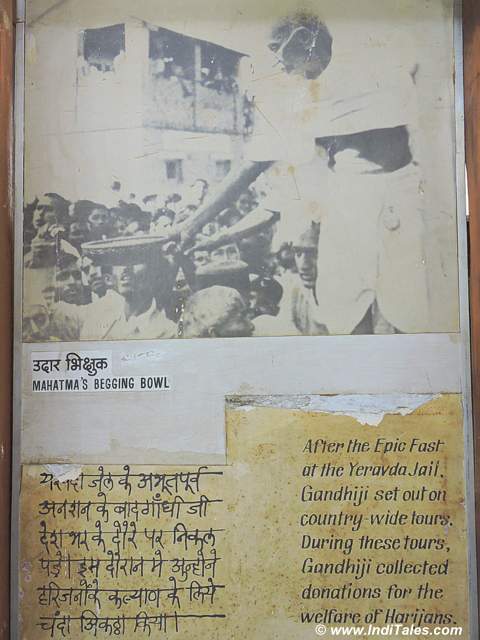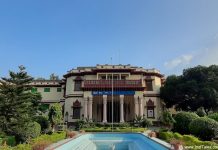Aga Khan Palace is a beautiful Palace located in a quaint neighborhood of Yerwada in Pune.

History of Aga Khan Palace
It was built in 1892 after a famine to generate employment for the region’s people. So, the roots of this palace are in charity & noble thoughts. It took 5 years and 1000 workers to build it at the cost of Rs 12,00,000/-. The palace is spread across an estate of 19 acres with a built area of 7 acres.
Aga Khan Palace & Mahatma Gandhi

Aga Khan Palace served as the prison for Mahatma Gandhi in Pune from Aug 1942 to May 1944. He lived here along with his wife Kasturba, and his secretaries Mahadev Desai & Sarojini Naidu. In fact, both Kasturba Gandhi and Mahadev Desai died on the premises of this palace-turned-prison. A corner of the Palace premises serves as the Samadhi dedicated to two of them. Some of the ashes of Mahatma Gandhi are placed next to the two samadhis. Samadhis are nothing but Tulasi plants growing on top of the places where Kasturba and Mahadev Desai were cremated.

A poem in Marathi dedicated to Kasturba adorns a red wall nearby.

Honestly, when you walk around this Palace with sprawling gardens, long corridors, and huge rooms, you wonder if you could really call it imprisonment. I assume there was no restriction on movement within the large campus of the palace. Maybe the residents could even step out – this was an era long before media watch came into vogue.
Who is Aga Khan?

Sir Sultan Muhammed Shah Aga Khan III was the 48th Imam of Khoja Ismaili Muslims. He founded the All India Muslim League and actively worked toward the rights of Muslims in India. He was one of those who demanded the creation of a separate nation-state for Indian Muslims albeit within India.
Aga Khan III was born to an elite family in Karachi and attended Eton & Cambridge University. He received quite a few distinctions from the British Government during his life. Notice the prefix Sir before his name. He owned many racing horses. He married multiple women in his lifetime. Before getting buried in Aswan, Egypt, he authored a few books including his own memoirs.
Aga Khan IV who was the grandson of Aga Khan III donated this Palace to the people of India in 1969. Technically it belongs to Gandhi Samarak Nidhi, Government of India. This was his way of paying respect to the father of the nation.
Read more about him on his Wikipedia page
Walking around the Aga Khan Palace

It is a great place for you to walk around in peace. The building is surrounded by tall trees. For some time I detested not getting a perfect picture. But then I realized that the trees are an integral part of the ambiance of the place.
The structure in pale grey with the red slanting roof is elegant – making it look rich in a very subtle manner. Now, I am not sure, if it was always like this or has been made to look so after it became a national memorial in the memory of Mahatma Gandhi.
Gandhi Museum

The rooms that were used by them now serve as a museum to them. They are spartan and simple in taste. There are personal items of his on display like utensils, slippers, clothes, and letters.
The big hall at the entrance has a large statue of his. The large paintings around, them paint them literally as an avatar. There are old black-and-white pictures of him during the freedom movement. A particularly impactful picture is that of him with a begging bowl in front of a huge crowd.

The next room has a diorama of him lifting a small child. This sculpture is surrounded by colorful paintings depicting the events from his life. Paintings continue to the next room where there is a round table in the middle with 7 chairs – lying within a barricade to protect it from visitors.
Gandhi’s hand-written letter
Another interesting display is a hand-written letter that he wrote on the death of his secretary Mahadev Desai. I am sure this is a replica as he was supposed to have very bad handwriting.

The upper stories of the building and some rooms towards the back side are inaccessible to visitors. I assume they serve as offices.
I saw a lot of photography students practicing photography, especially fashion photography using the monument and its well-maintained lawns as the backdrop.
As I walked towards the back of the building, I could see a glass enclosure on top. It strangely reminded me of the Falaknuma Palace in Hyderabad. There is some uncanny similarity in the architectural style and the color scheme. A few thoughts later, I realized that both buildings are contemporary and probably have the same inspiration, though a century later their fates are as different as they can be.
Other things See and Know at the complex

Apart from the above the premises has:
- A library
- A Bookstall that sells Gandhi Literature
- A Khadi Gramodyog sales outlet
- A training center for women
- UNHCR Office
- Children’s Film Club
Celebrations
Before I visited, my Internet research said that there are regular bhajans or singing that happens here. The staff completely denied anything like that.
- 24th January – National Girl Child Day
- 26th January – Republic Day
- 30th January – Gandhi’s Death Anniversary
- 22nd Feb – or Mahashivratri
- 8th March – Women’s Day
- 15th August – Independence Day
- 2nd Oct – Gandhi Jayanti
- 14th Nov – Children’s Day
From the swanky Kalyani Nagar, where I was staying, I walked to this historic monument one evening. I bought the ticket and was blissfully told that I could take pictures. I have so gotten used to being told ‘Photography is not Allowed’, that when it is allowed I look up and thank my stars.
Other Homes of Gandhi’s In India include:
- Satyagraha Ashram – Kochrab, Ahmedabad
- Mani Bhavan – Mumbai
- Sabarmati Ashram – Ahmedabad














Immensely useful and informative post with utterly beautiful pictures. I visited this place just a few months back and got immense peace of mind there.
Thanks Jitendra. Yes, it is a very peaceful place and very nicely maintained.
Been there..very peaceful place, and gardens are well maintained. But it’s isn’t a popular place among youths. The Pheonix Mall few meters away.. get’s more attention. The artifacts are well preserved, the location makes you sit.. and reminds of all the struggle, and attention this place had years back. Thanks for the post.
Thanks, Harish. I saw some young people practising their photography skills there. I would also like to understand what would youngsters or anyone do there – I would rather have this an active place that people can use for meetings, seminars etc.
GOOD
Thank you Yoyo.
Pune has more than 30 lacks people. This place is really peaceful.
There are other some places you can visit in Pune like Parwati , Shaniwar wada, Sinhgad fort, Mahatma Phule wada
Janardhan, I did visit Shaniwar Wada this time, Sinhgad fort I visited more than 20 years ago and Parwati & Mahatma Phule Wada probably next time.
Very good informative post. Fortunately or unfortunately now-a-days, I am seeing a lot of pre-wedding shoots and photography of the new husband-wife being done in the gardens.
I am happy that people are shooting their happy moments here. The monument becomes a part of their memories and lives.
Wedding shoots do not harm it in any way, I assume.